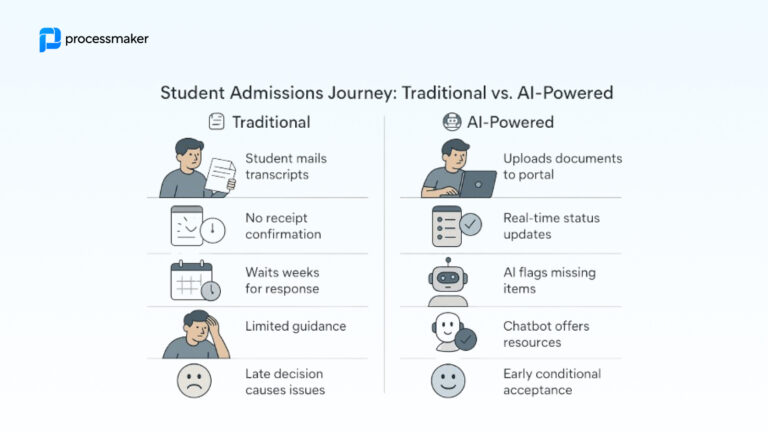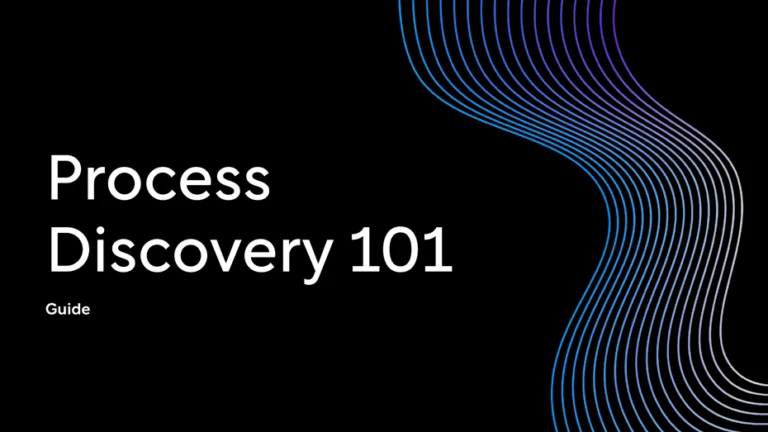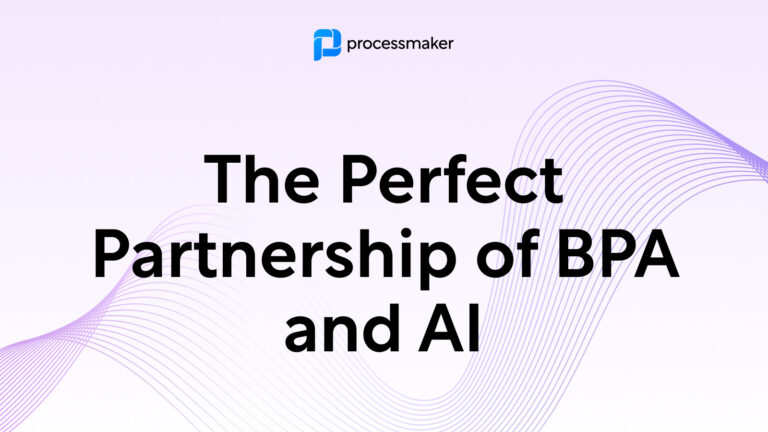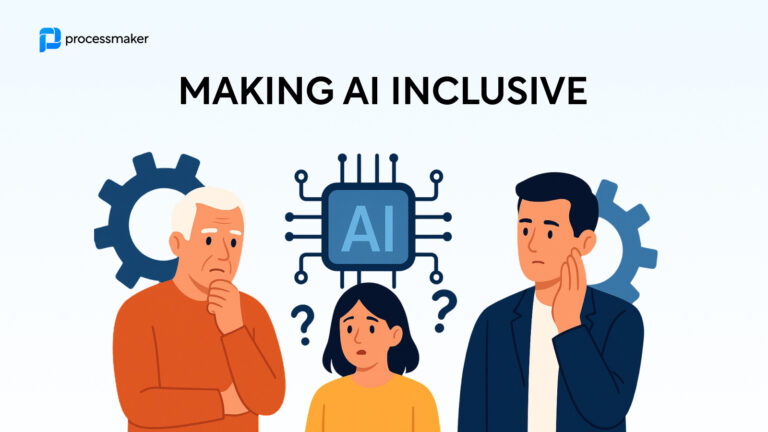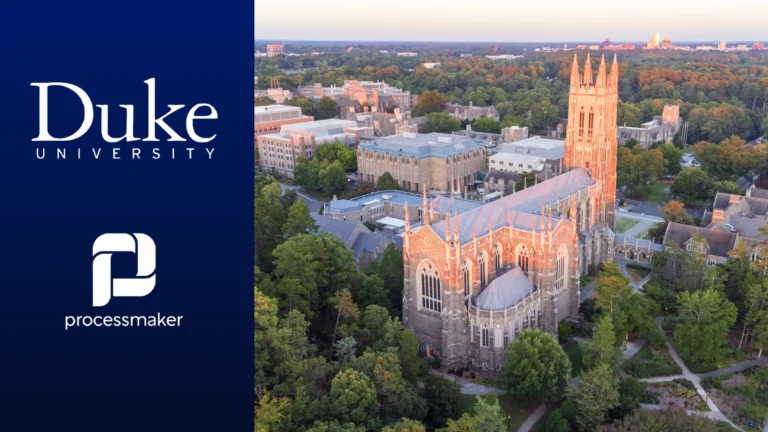In a world where digital transformation has touched nearly every corner of higher education, the admissions process remains one of the most critical experiences for prospective students. Lengthy response times, manual paperwork, and unclear communication can turn an exciting journey into a frustrating one. As institutions compete for top talent and strive to improve student outcomes, the need for intelligent, scalable, and personalized onboarding has never been more urgent.
Enter AI-powered onboarding: a new approach to admissions that blends intelligent automation with empathy and accessibility, enabling universities to streamline decisions, improve transparency, and build deeper connections with students from day one.
The Admissions Experience Is Broken — But Fixable
Admissions teams are under pressure like never before. Application volumes are rising, student expectations are higher, and competition among institutions is fierce. Yet, behind the scenes, many offices still rely on legacy systems, disconnected workflows, and manual data entry.
Key challenges include:
- Fragmented document intake: Transcripts, test scores, and recommendation letters often arrive through different channels and formats.
- Delays in decisions: Human-led review processes can take weeks, even for straightforward cases.
- Inequitable experiences: Students without access to guidance or persistent follow-up can fall through the cracks.
- Overburdened staff: Admissions professionals spend more time chasing documents than engaging with applicants.
What’s needed is a system that scales without sacrificing the human touch.
What Does AI-Powered Onboarding Look Like?
AI-powered onboarding in higher education isn’t just about replacing humans — it’s about augmenting them. It automates the repetitive and rule-based aspects of admissions, freeing staff to focus on high-value, student-facing work.
Key capabilities include:
- Document recognition and classification
AI can extract data from PDFs, scanned transcripts, and application forms, automatically routing them to the correct departments. - Eligibility checks
Using pre-set rules and predictive analytics, AI systems can determine if an applicant meets program requirements or needs further review. - Real-time status updates and nudges
Intelligent chatbots and automated messages keep students informed about missing documents, next steps, or deadlines. - Decision support
AI can score or prioritize applications based on customized rubrics, ensuring faster and more consistent initial evaluations.
A Human-Centered Approach to Automation
Critics of AI in admissions often point to concerns about bias, fairness, and depersonalization. These concerns are valid and must be addressed proactively.
That’s why human-in-the-loop AI is the model to embrace. It doesn’t remove people from the process; it enhances their effectiveness. Admissions officers retain full control over final decisions, with AI simply handling triage and logistics.
Equally important is transparency. Students want visibility into where they are in the process, what’s needed next, and how long things will take. AI systems can provide dashboards and alerts that reduce anxiety and foster trust.
A Student’s Journey: Traditional vs. AI-Enhanced
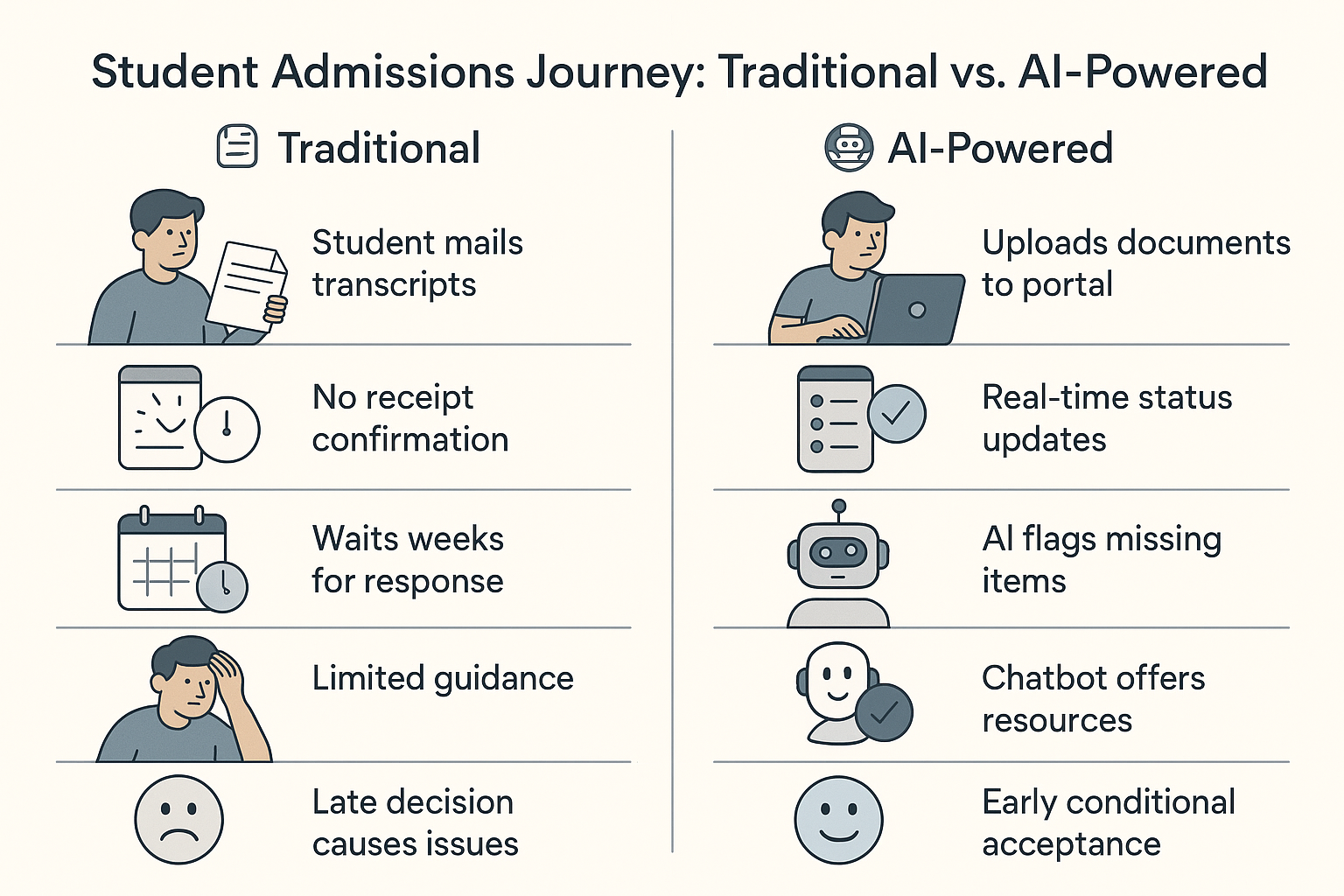
The result? A smoother, faster, and more confident decision to enroll.
Implementing AI in Admissions: What to Consider
For universities looking to bring AI into their admissions process, here are a few best practices:
- Ensure SIS and CRM integration
AI tools should connect seamlessly with platforms like Banner, Ellucian, or Salesforce Education Cloud. - Adopt an agile approach
Start with one workflow (like transcript intake) and scale from there. - Build for compliance
Systems must respect data privacy standards like FERPA and GDPR. - Train admissions staff
Help teams understand AI’s role, limitations, and benefits — fostering trust and adoption.
Ethical Considerations and Bias Mitigation
As AI becomes more prevalent in admissions, ethical considerations become paramount. Algorithmic fairness requires continuous monitoring to ensure that AI systems don’t perpetuate or amplify existing biases in educational access. Universities must regularly audit their AI systems for disparate impact on protected groups and adjust algorithms accordingly.
Transparency requirements are evolving rapidly. Students have a right to understand how AI influences their admissions decisions. Universities must balance the need for transparency with the protection of proprietary algorithms and competitive advantages. Clear policies about AI use, regular bias audits, and accessible explanations of automated decisions are becoming standard practice.
The Future of Admissions Is Proactive and Predictive
Looking ahead, the role of AI won’t stop at onboarding. Universities will use intelligent systems to:
- Predict which students are likely to accept offers (and why).
- Customize onboarding materials based on applicant profiles.
- Identify risk factors early to drive student success interventions.
This evolution transforms admissions from a gatekeeping function into a strategic enabler of institutional goals — enrollment, retention, and equity.
Where ProcessMaker Fits In: Automation with a Human Touch
ProcessMaker plays a pivotal role in helping higher ed institutions embrace this AI-powered future.
With its workflow automation platform tailored for Higher Education, ProcessMaker enables universities to:
- Automate document-driven workflows (e.g., transcript evaluations, financial aid checks).
- Implement intelligent routing of applications based on program, eligibility, or student type.
- Create customizable forms that collect, validate, and trigger actions based on student responses.
- Maintain visibility and control with real-time dashboards and human approval steps.
Best of all, ProcessMaker combines power with flexibility — allowing institutions to design AI-assisted onboarding journeys that reflect their unique values, branding, and admissions philosophy.
By automating the mundane while elevating the human, ProcessMaker helps universities deliver an admissions experience that is faster, smarter, and more personal.
Final Thoughts
Admissions is no longer just about who gets in — it’s about how students feel from the first click to the first day. With AI-powered onboarding, higher education can rise to meet the demands of the digital age while staying true to its mission: serving students with empathy, equity, and excellence.
The future is here — and it’s intelligently human.
